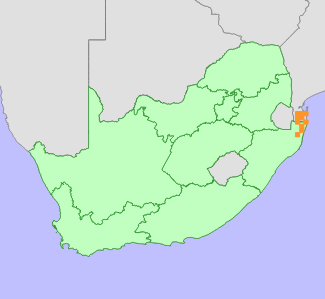|
Scientific Name | Dicerocaryum forbesii (Decne.) A.E.van Wyk |
Higher Classification | Dicotyledons |
Family | PEDALIACEAE |
Synonyms | Dicerocaryum senecioides (Klotzsch) Abels subsp. senecioides (1975) (in part), Dicerocaryum zanguebarium (Lour.) Merr. (1935) (in part), Pretrea forbesii Decne., Pretrea zanguebaria (Lour.) J.Gay ex DC. in sense of Stapf. (1904) (in part) |
National Status |
Status and Criteria | Least Concern |
Assessment Date | 2016/10/10 |
Assessor(s) | D. Raimondo, H. Matimele, J.E. Burrows & A.E. van Wyk |
Justification | Dicerocaryum forbesii is an endemic to the Maputaland Centre of Endemism, extending from northern KwaZulu-Natal, South Africa to southern Maputo Province, southern Mozambique (global EOO 5132 km², national EOO 4291 km²). Although it is a range-restricted endemic, it is locally common, and favoured by disturbance such as forest clearing for shifting subsistence agriculture and harvesting of wood for fuel. In areas where these are the dominant land uses available habitat is increasing for this species. It is therefore not considered to be in danger of extinction. |
Distribution |
Endemism | Not endemic to South Africa |
Provincial distribution | KwaZulu-Natal |
Range | A Maputaland coastal plain endemic, recorded from Mkuze in KwaZulu-Natal, South Africa to Licuati Forest Reserve in Maputo Province, southern Mozambique,. |
Habitat and Ecology |
Major system | Terrestrial |
Major habitats | Indian Ocean Coastal Belt |
Description | Dicerocaryum forbesii is a prostrate herb with a perennial taproot (Van Wyk and Condy 2003) from which the species produces radiating stems growing along the ground. It prefers the characteristic pale sandy soils of the Maputaland coastline. It is found in open wooded coastal grassland on bare sands in full sun (Van Wyk and Condy 2003, Bandeira and Paula 2014). However, it is also often found within disturbed areas such as abandoned croplands and grazing sites (Van Wyk and Condy 2003). Field surveys in 2015 recorded the species in wooded grassland on pale sand with thicket clumps of Strychnos madagascariensis, Terminalia sericea, and some geophytes such as Crinum delagoensis, Scadoxus species. It was also found on the clay soils in an open grasslands that are widely used for grazing and subsistence cultivation. Animals and humans aid the widespread dispersal of Dicerocaryum forbesii's seeds, which has two persistent spikes which can become lodged in the hooves of animals (Van Wyk and Condy 2003). |
Threats |
| In southern Mozambique, dried roots of D. forbesii are used to treat fevers in babies. The dried roots are crushed into a powder and mixed into water which is then used to wash the baby (Van Wyk and Condy 2003). The species is also used to make other hygiene products such as soap or shampoo. The impact of harvesting on the population of D. forbesii is not known, but is not suspected to be negative, as this species spreads quickly and is resilient to disturbance. Across this species' range, the dominant land uses are shifting agriculture and clearing of forests for wood or charcoal production. Field observations however indicate that D. forbesii proliferates following disturbance, and therefore these land uses, which threaten many other native plant species, favours the spread of D. forbesii by increasing available habitat. Therefore the only severe threat is complete habitat loss to urban, industrial and other infrastructure. While these land uses are slowly increasing they are not suspected to impact more than 3% of this species range at present. |
Population |
There are several known subpopulations both in KwaZulu-Natal and southern Mozambique. Field surveys in and around Licuati Forest Reserve indicate that it is spreading in areas recently cleared for subsistence agriculture and charcoal production, and that it is most abundant in heavily grazed rangelands. As forest clearing is ongoing, this species' population size is likely to be increasing.
|
Population trend | Increasing |
Assessment History |
Taxon assessed |
Status and Criteria |
Citation/Red List version | | Dicerocaryum forbesii (Decne.) A.E.van Wyk | Least Concern | Raimondo et al. (2009) | |
Bibliography |
Raimondo, D., von Staden, L., Foden, W., Victor, J.E., Helme, N.A., Turner, R.C., Kamundi, D.A. and Manyama, P.A. 2009. Red List of South African Plants. Strelitzia 25. South African National Biodiversity Institute, Pretoria.
Van Wyk, A.E. and Condy, G. 2003. Dicerocaryum forbesii and D. senecioides. Flowering Plants of Africa 58:118-133.
|
Citation |
| Raimondo, D., Matimele, H., Burrows, J.E. & van Wyk, A.E. 2016. Dicerocaryum forbesii (Decne.) A.E.van Wyk. National Assessment: Red List of South African Plants version 2024.1. Accessed on 2025/11/22 |
 Comment on this assessment
Comment on this assessment


